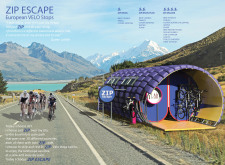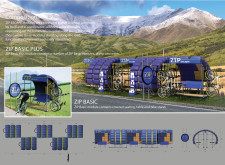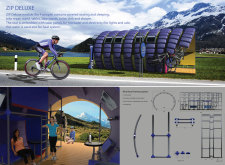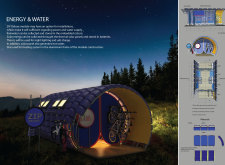5 key facts about this project
The architecture of the ZIP ESCAPE comprises four distinct variants: ZIP Basic, ZIP Basic Plus, and ZIP Deluxe. Each variant scales in complexity and functionality, accommodating a range of cyclist needs. The ZIP Basic offers fundamental features such as covered seating, a table, and a bike stand, serving as a straightforward shelter for short breaks. The ZIP Basic Plus builds on this by adding a water pump, increasing utility and comfort for longer rides.
The ZIP Deluxe variant is particularly notable for its comprehensive services, intended for up to four users. This module includes additional amenities such as shower facilities, a toilet and sink, and a dedicated bike repair station. Furthermore, solar panels are integrated within the design, allowing for a self-sustaining energy solution that highlights the growing emphasis on environmental responsibility in architecture.
Sustainability and modularity distinguish the ZIP ESCAPE project from traditional bike stops. The decision to employ materials such as aluminum for structural framework and waterproof fabric for exterior walls reflects the project's focus on longevity and resilience in varying weather conditions. Wooden flooring enhances user comfort, contributing to an inviting interior atmosphere. The modular design means that different configurations can be deployed based on specific locations and traffic demands, offering flexibility that many standard rest stops lack.
The ZIP ESCAPE's approach to architectural design emphasizes both functionality and aesthetics, harmonizing with the surrounding landscapes of Europe. Its thoughtful integration of solar energy and rainwater capture systems not only supports cyclist needs but also aligns with broader sustainability goals. The project exemplifies how architecture can provide practical solutions without compromising environmental integrity.
For further insights into the architectural plans, architectural sections, and architectural designs that underpin the ZIP ESCAPE project, interested readers are encouraged to explore the project presentation. Understanding these architectural ideas will provide a deeper appreciation of how this design meets the needs of modern cyclists while fostering sustainable practices.


























